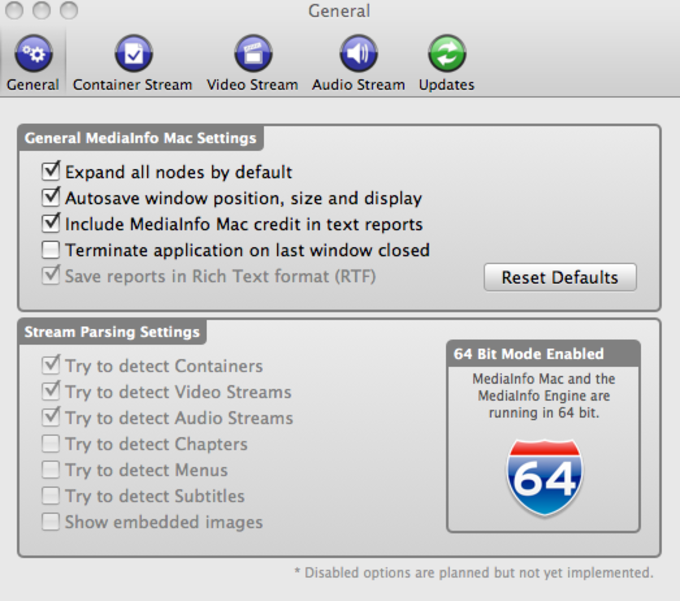
- App mac mediainfo how to#
- App mac mediainfo movie#
- App mac mediainfo code#
- App mac mediainfo series#
- App mac mediainfo download#
To generate MediaInfo files using the GUI version of MediaInfo, you must open the media files with MediaInfo and select Export from the File menu. However, you can still generate single files to use as the reference, since only one is required. It is currently not possible to generate individual MediaInfo files automatically for a group of files using the GUI (Graphic User Interface) version of MDQC. However, as with the desktop app, it is only possible to generate one file at a time.
App mac mediainfo download#
You can change the output format and download a report directly from the website. Simply drag and drop the file you wish to create a MediaInfo export for. It is possible to generate MediaInfo files online here: More details about this new feature are also available in our previous post. You can download the latest versions of MediaInfo here.

In this post we will guide you through the creation of MediaInfo files for both Mac and Windows platforms. In order to use the new MediaInfo feature, you will need to export MediaInfo files for the files you wish to reference and/or for those that will replace your media files in the scanning process. Since MediaInfo files are text based, these can be easily sent over email or shared in online storage applications, without the hassle of moving around large media files. This new feature is useful in any scenario in which security or bandwidth are impediments to performing quality control on the media files themselves. MediaInfo is an open source tool that displays technical metadata for media files. One of the new functionalities allows users to use MediaInfo files as surrogates for media files. If you are new to MDQC, we recommend you to read the MDQC User Guide first so you are familiar with the application’s basic functionalities.
App mac mediainfo series#
We have published a series of reviews of MDQC’s newest features on the blog section of our website. In this version, we have incorporated new features that allow more control and independence over the filtering and scanning process. MDQC is available for both Mac and Windows users. The creation of a series of rules allows a user to specify which fields they wish to QC and which files in a given folder the application should scan. Using ExifTool and MediaInfo, MDQC compares embedded metadata of batches of media files to the metadata found in a reference file defined by the user. In short, if you use pymediainfo indicate that you use pymediainfo so people are not confused when you want an answer about pymediainfo but you say you use MediaInfo within Python.This month, we released the newest version of our free tool MDQC, which allows users to easily perform metadata quality control. FYI "Movie" and "Title" are synonym in MediaInfo, pymediainfo prefered "title". dylib) and my example works very well on your "Linux world" pymediainfo is a third party binding with its own interface but in practice this is similar field names as pymediainfo uses MediaInfo field names. MediaInfo has a Python binding (for Windows/macOS/Linux, "DLL" stands for dynamic loaded library and is the generic name in MediaInfo for all platforms, it works well within Windows.
App mac mediainfo how to#
You can have examples about how to use the Python binding (including the list of field names) at this place.Įdit for answering your edit: your first question was about MediaInfo within Python (and is still the title of the question), not "pymediainfo", I answered with MediaInfo within Python.

The Python equivalent is: MI = MediaInfo() Mediainfo -Inform="General %Movie%" file.avi
App mac mediainfo code#
I'm baffled with it all, and as the code is buried within the application diagnostics are hard. Which is entirely different syntax from your suggestion, and the example talks about DLLs which don't exist in my Linux world. Info.pixeldimensions = "%dx%d" % (track, track)

Mediainfo = MediaInfo.parse(filename) duration = 0 The code I'm looking at is nemo-media-columns.py ( ) has NO IDEA WHY THIS SITE ONLY ALLOWS VERY SHORT COMMENTS, BELOW IS A COMMENT

The sparse documentation and all examples talk about track structures, when my item is in General In python I have access to the mediainfo structure mediainfo = MediaInfo.parse(filename)īut nowhere can I find out how the command line matches to the data structure.
App mac mediainfo movie#
I can get the Movie name from my avi files with the command line mediainfo -Inform="General %Movie%" file.avi


 0 kommentar(er)
0 kommentar(er)
